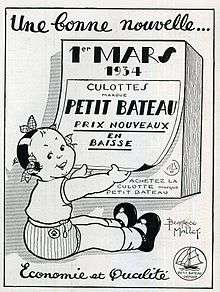Petit Bateau
| Industry | Textile |
|---|---|
| Founded | 1920 |
| Founder | Pierre Valton |
| Headquarters | Troyes, France |
Key people | Patrick Pergament (CEO) |
| Revenue | € 280 million in 2011 |
| Owner | Yves Rocher Company |
Number of employees | About 4000 people |
| Website | www.petit-bateau.com |
Petit Bateau is a French brand of clothes and underwear founded in 1920 in Troyes.
History
The origins of the brand dates back in 1893. Pierre Valton, former hosier in Troyes, is married to Noémie Quincarlet, the daughter of his former employer. At that time, he founded his own hosiery with his three sons. This factory is named Valton-Quincarlet & Fils and is specialized in long johns, jackets and riding pants.

In 1918, Etienne Valton, son of Pierre Valton invented the modern underpants cutting the legs of the long johns. In 1920, he patented the brand Petit Bateau. According to the legend, Pierre Valton was inspired by the French children's song "Maman, les p'tits bateaux" that his son was singing.[1] At the same time, it is the beginning of the campaigns Petit Bateau with the character of Marinette drawn by Beatrice Mallet. Marinette is a smiling and mischievous little girl who reflects the image of the brand.
In the 1970s, the brand is in debt. So in 1988 Yves Rocher (company), No. 1 of the beauty by mail order in France bought the company Petit Bateau. Yves Rocher justifies this purchase by his new career in the textile industry and his love for brands. As of this year in order to start sales, he decided to introduce the brand in supermarkets, with different collections from those in store. Thus the brand becomes the leader in selling underwear in supermarkets and hypermarkets.
In 1994, Petit Bateau becomes a fashionable brand thanks to the fashion designer Karl Lagerfeld. Indeed for a fashion show, he dressed the model Claudia Schiffer with a Petit Bateau T-shirt under a Chanel suit. So a lot of women went to the store to buy these T-shirts originally created for children.[2]
In 2000, Petit Bateau opens a store on the Champs Elysées in Paris while in 2006, the brand opens its first online store, which is the beginning of its e-commerce.
Internationally, in 2001 Petit Bateau comes in English speaking countries with a store in London and two new stores in New York. In 2008 the brand has nearly 400 shops and a presence in over 60 countries around the world.[3] the company has nearly 4000 employees including about 1000 in the region of Troyes.
Each year Petit Bateau sells worldwide 4 million T-shirts, 3 million underpants, and 17 million underwear.
Features
The brand wants to be multigenerational for babies, children, women and men. .[4]
In the field of children's clothing, the competing brands of Petit Bateau are registered as Vertbaudet, Sergent Major and Okaïdi. The general manager of Petit Bateau, Patrick Pergament said the company shares an expression that is "Petit Bateau is 50 per cent love and 50 per cent cotton." [5]
The company
In 2011 Petit Bateau achieves a turnover of 280 million euros. This same year, the brand has a total of 400 stores, and that in Europe, the US, Japan and the Middle East. Moreover 45% of sales of Petit Bateau are international and 80% of the production still takes place in Troyes, the hometown of the brand.[6]
References
- ↑ « Petit Bateau », by Lise Huret on tendances-de-mode.com, May 19, 2010 (consulted October 27, 2014).
- ↑ « Elle porte la culotte », by Julia Tissier on liberation.fr , August 11, 2009 (consulted October 27, 2014).
- ↑ « The history » Petit Bateau China 2014 on petit-bateau-cn.com (consulted October 27, 2014).
- ↑ « The Petit Bateau Story », About the Brand on petit-bateau.co.uk (consulted October 27, 2014).
- ↑ « Petit Bateau: the boat that rocked », by Wendy Douglas on fashion.telegraph.co.uk, August 20, 2013 (consulted October 27, 2014).
- ↑ « Petit Bateau vogue sur les codes de l'enfance » by Magali Picard on lsa-conso.fr, April 5, 2012 (consulted October 27, 2014).